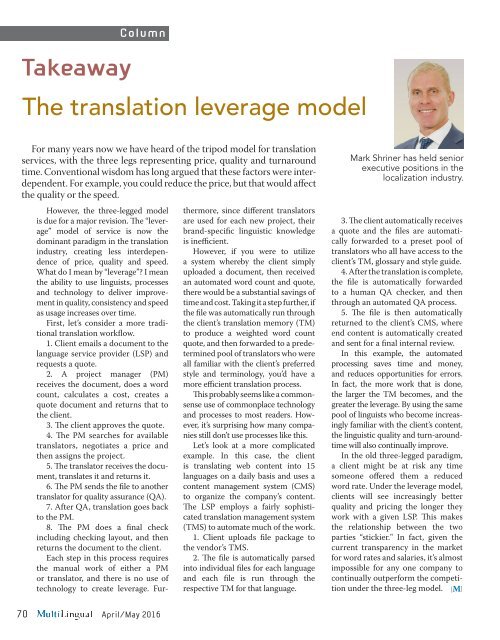Localization
z99kl79
z99kl79
You also want an ePaper? Increase the reach of your titles
YUMPU automatically turns print PDFs into web optimized ePapers that Google loves.
Takeaway<br />
Column<br />
The translation leverage model<br />
For many years now we have heard of the tripod model for translation<br />
services, with the three legs representing price, quality and turnaround<br />
time. Conventional wisdom has long argued that these factors were interdependent.<br />
For example, you could reduce the price, but that would affect<br />
the quality or the speed.<br />
However, the three-legged model<br />
is due for a major revision. The “leverage”<br />
model of service is now the<br />
dominant paradigm in the translation<br />
industry, creating less interdependence<br />
of price, quality and speed.<br />
What do I mean by “leverage”? I mean<br />
the ability to use linguists, processes<br />
and technology to deliver improvement<br />
in quality, consistency and speed<br />
as usage increases over time.<br />
First, let’s consider a more traditional<br />
translation workflow.<br />
1. Client emails a document to the<br />
language service provider (LSP) and<br />
requests a quote.<br />
2. A project manager (PM)<br />
receives the document, does a word<br />
count, calculates a cost, creates a<br />
quote document and returns that to<br />
the client.<br />
3. The client approves the quote.<br />
4. The PM searches for available<br />
translators, negotiates a price and<br />
then assigns the project.<br />
5. The translator receives the document,<br />
translates it and returns it.<br />
6. The PM sends the file to another<br />
translator for quality assurance (QA).<br />
7. After QA, translation goes back<br />
to the PM.<br />
8. The PM does a final check<br />
including checking layout, and then<br />
returns the document to the client.<br />
Each step in this process requires<br />
the manual work of either a PM<br />
or translator, and there is no use of<br />
technology to create leverage. Furthermore,<br />
since different translators<br />
are used for each new project, their<br />
brand-specific linguistic knowledge<br />
is inefficient.<br />
However, if you were to utilize<br />
a system whereby the client simply<br />
uploaded a document, then received<br />
an automated word count and quote,<br />
there would be a substantial savings of<br />
time and cost. Taking it a step further, if<br />
the file was automatically run through<br />
the client’s translation memory (TM)<br />
to produce a weighted word count<br />
quote, and then forwarded to a predetermined<br />
pool of translators who were<br />
all familiar with the client’s preferred<br />
style and terminology, you’d have a<br />
more efficient translation process.<br />
This probably seems like a commonsense<br />
use of commonplace technology<br />
and processes to most readers. However,<br />
it’s surprising how many companies<br />
still don’t use processes like this.<br />
Let’s look at a more complicated<br />
example. In this case, the client<br />
is translating web content into 15<br />
languages on a daily basis and uses a<br />
content management system (CMS)<br />
to organize the company’s content.<br />
The LSP employs a fairly sophisticated<br />
translation management system<br />
(TMS) to automate much of the work.<br />
1. Client uploads file package to<br />
the vendor’s TMS.<br />
2. The file is automatically parsed<br />
into individual files for each language<br />
and each file is run through the<br />
respective TM for that language.<br />
Mark Shriner has held senior<br />
executive positions in the<br />
localization industry.<br />
3. The client automatically receives<br />
a quote and the files are automatically<br />
forwarded to a preset pool of<br />
translators who all have access to the<br />
client’s TM, glossary and style guide.<br />
4. After the translation is complete,<br />
the file is automatically forwarded<br />
to a human QA checker, and then<br />
through an automated QA process.<br />
5. The file is then automatically<br />
returned to the client’s CMS, where<br />
end content is automatically created<br />
and sent for a final internal review.<br />
In this example, the automated<br />
processing saves time and money,<br />
and reduces opportunities for errors.<br />
In fact, the more work that is done,<br />
the larger the TM becomes, and the<br />
greater the leverage. By using the same<br />
pool of linguists who become increasingly<br />
familiar with the client’s content,<br />
the linguistic quality and turn-aroundtime<br />
will also continually improve.<br />
In the old three-legged paradigm,<br />
a client might be at risk any time<br />
someone offered them a reduced<br />
word rate. Under the leverage model,<br />
clients will see increasingly better<br />
quality and pricing the longer they<br />
work with a given LSP. This makes<br />
the relationship between the two<br />
parties “stickier." In fact, given the<br />
current transparency in the market<br />
for word rates and salaries, it’s almost<br />
impossible for any one company to<br />
continually outperform the competition<br />
under the three-leg model. [M]<br />
70 April/May 2016


